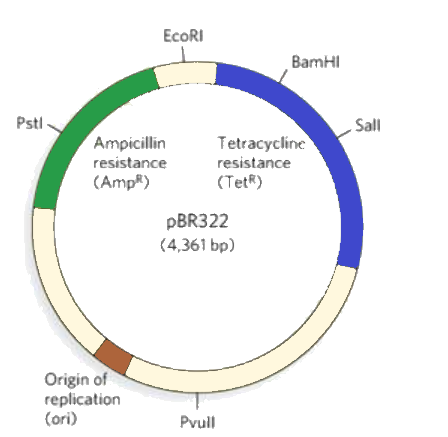
Draw a schematic sketch of pBR322 plasmid and label the following in it.
A) Any two restriction sites
B) Ori and rop genes
C) An antibiotic resistant gene
Answer
488.1k+ views
Hint: pBR322 is a plasmid and was one of the first commonly used E. coli cloning vectors. Formed in 1977, it was named after Francisco Bolivar Zapata and Raymond L. Rodriguez. The genes present in pBR322 for tetracycline and ampicillin resistance enzymes, as well as sites where it can be cut by definite restriction endonucleases and identical DNA sequences inserted.
Complete answer:

pBR322 is a 4,362-bp ds DNA plasmid cloning vehicle aimed to authorize the easy and rapid formation of cloned recombinant DNA portions. It has two antibiotic resistance genes, an origin of replication, and a multiplicity of functional restriction sites for cloning or subcloning restriction segments. pBR327 is alike to pBR322, apart from that it is the absence of all nucleotides between 1,427 and 2,516.
An origin of replication is a DNA series in which replication is initiated on a gene, plasmid or virus is the cause of replication. Rop is a small protein responsible for keeping ColE1 and associated bacterial plasmids down in their copy number.
These sequences are removed to reduce the size of the cloning vector and to eradicate sequences, which obstruct the expression of cloned DNA in eukaryotic cells. pBR322 and pBR322-derivative plasmids are very ordinary plasmid vectors.
Opening the plasmid with an RE and adding a companionable DNA segment with DNA ligase inactivates this resistance gene.
Hence, the correct answer is option ().
Note: Plasmids and bacteriophages are often used as a cloning vector in the DNA recombinant machinery. The ease with which plasmids can be tailored and replicated makes it an immense device in genetic engineering and biotechnology. For genetic engineering function, plasmids are artificially geared up in the lab. The lab-developed plasmids, which are used as a vector, enclose an origin of replication, cloning site, and selection marker.
Complete answer:

pBR322 is a 4,362-bp ds DNA plasmid cloning vehicle aimed to authorize the easy and rapid formation of cloned recombinant DNA portions. It has two antibiotic resistance genes, an origin of replication, and a multiplicity of functional restriction sites for cloning or subcloning restriction segments. pBR327 is alike to pBR322, apart from that it is the absence of all nucleotides between 1,427 and 2,516.
An origin of replication is a DNA series in which replication is initiated on a gene, plasmid or virus is the cause of replication. Rop is a small protein responsible for keeping ColE1 and associated bacterial plasmids down in their copy number.
These sequences are removed to reduce the size of the cloning vector and to eradicate sequences, which obstruct the expression of cloned DNA in eukaryotic cells. pBR322 and pBR322-derivative plasmids are very ordinary plasmid vectors.
Opening the plasmid with an RE and adding a companionable DNA segment with DNA ligase inactivates this resistance gene.
Hence, the correct answer is option ().
Note: Plasmids and bacteriophages are often used as a cloning vector in the DNA recombinant machinery. The ease with which plasmids can be tailored and replicated makes it an immense device in genetic engineering and biotechnology. For genetic engineering function, plasmids are artificially geared up in the lab. The lab-developed plasmids, which are used as a vector, enclose an origin of replication, cloning site, and selection marker.
Latest Vedantu courses for you
Grade 8 | CBSE | SCHOOL | English
Vedantu 8 CBSE Pro Course - (2025-26)
School Full course for CBSE students
₹45,300 per year
Recently Updated Pages
Master Class 4 Maths: Engaging Questions & Answers for Success

Master Class 4 English: Engaging Questions & Answers for Success

Master Class 4 Science: Engaging Questions & Answers for Success

Class 4 Question and Answer - Your Ultimate Solutions Guide

Master Class 11 Economics: Engaging Questions & Answers for Success

Master Class 11 Business Studies: Engaging Questions & Answers for Success

Trending doubts
What is the difference between resemblance and sem class 12 social science CBSE

Draw ray diagrams each showing i myopic eye and ii class 12 physics CBSE

Why do the transition elements have higher enthalpies class 12 chemistry CBSE

What are the advantages of parallel combination over class 12 physics CBSE

What are the causes of overloading class 12 physics CBSE

There is hypertension due to smoking Give scientific class 12 biology CBSE




